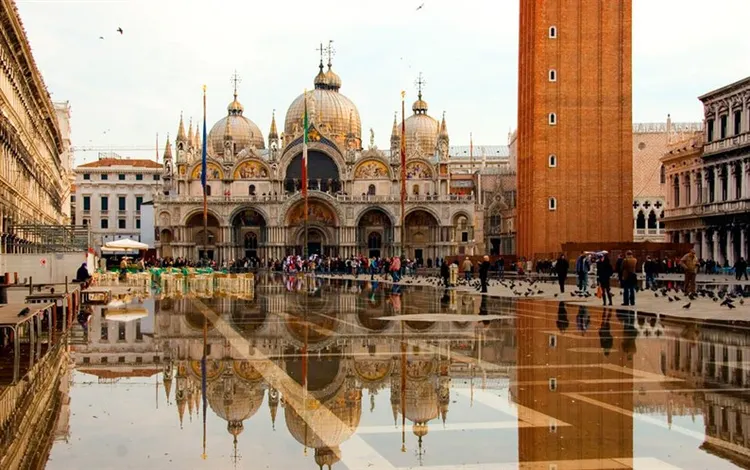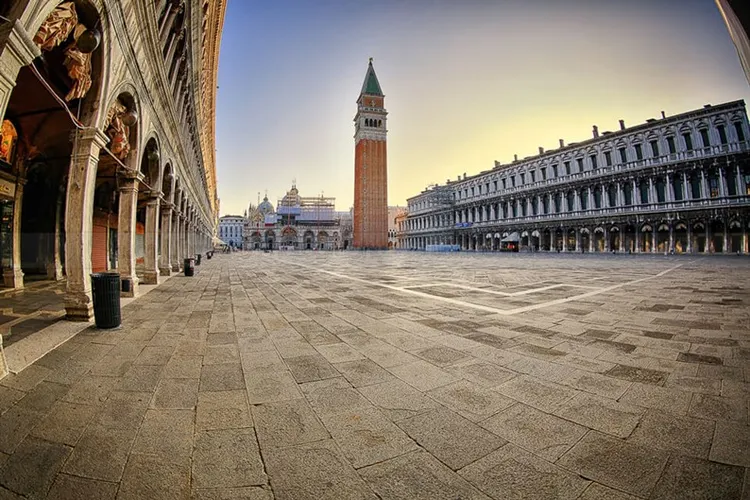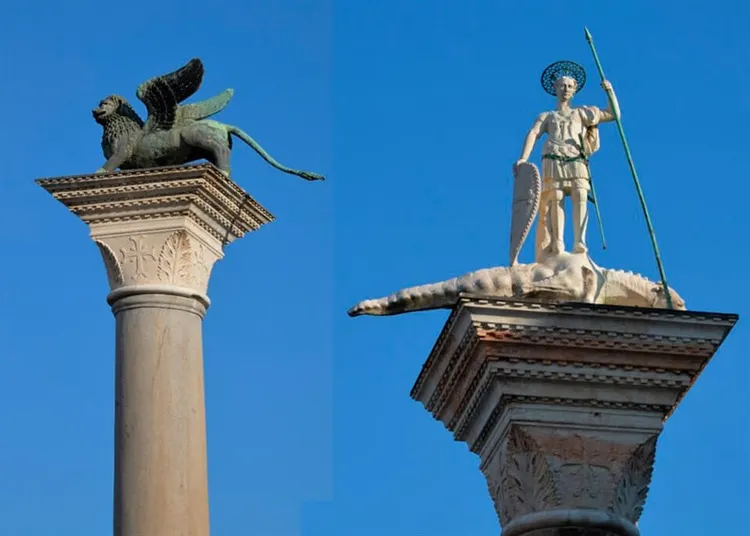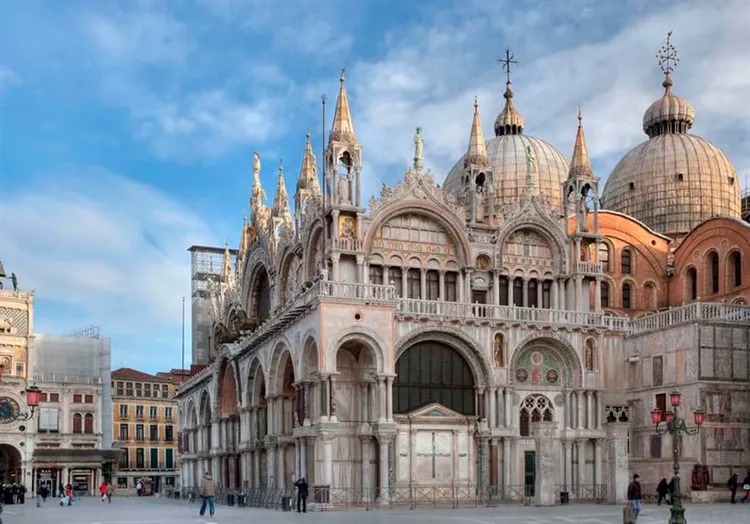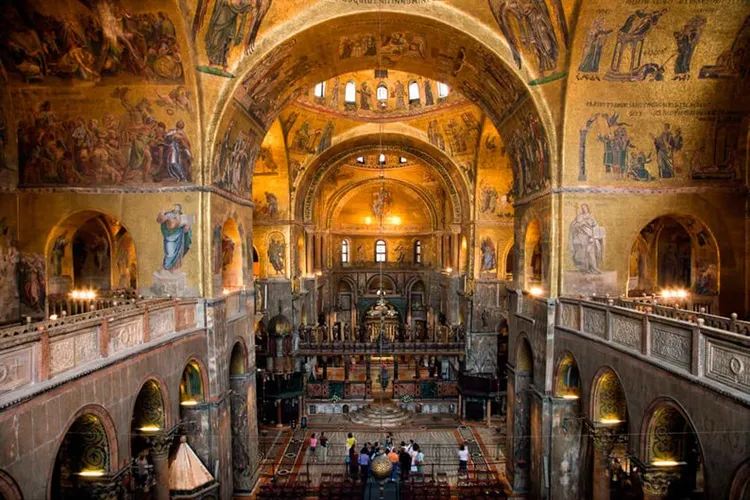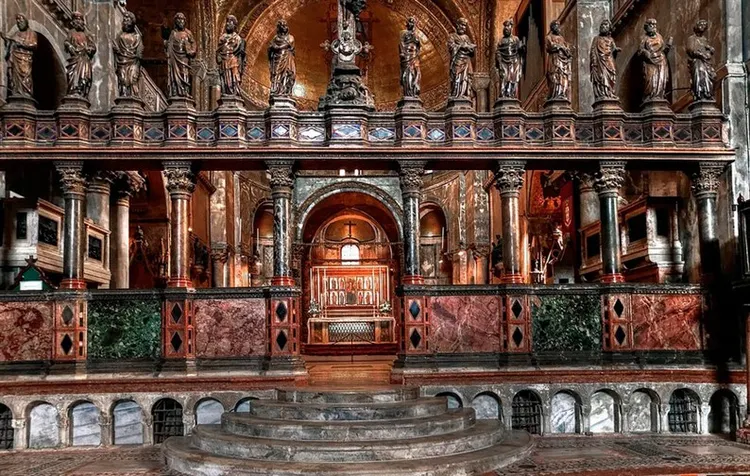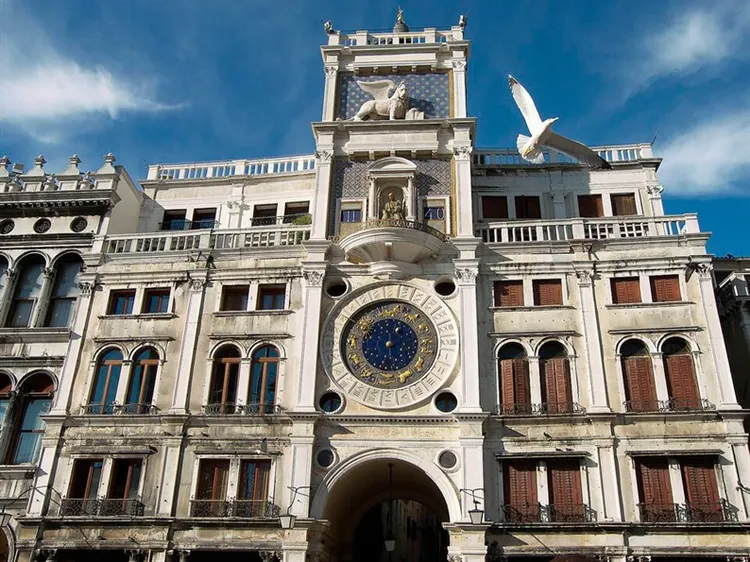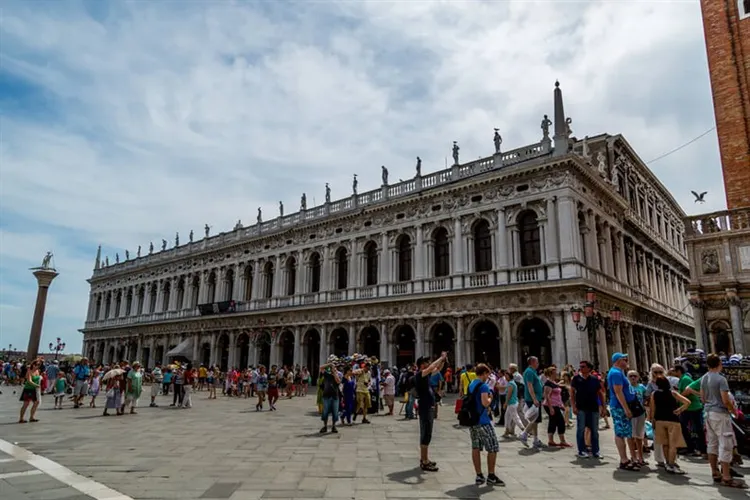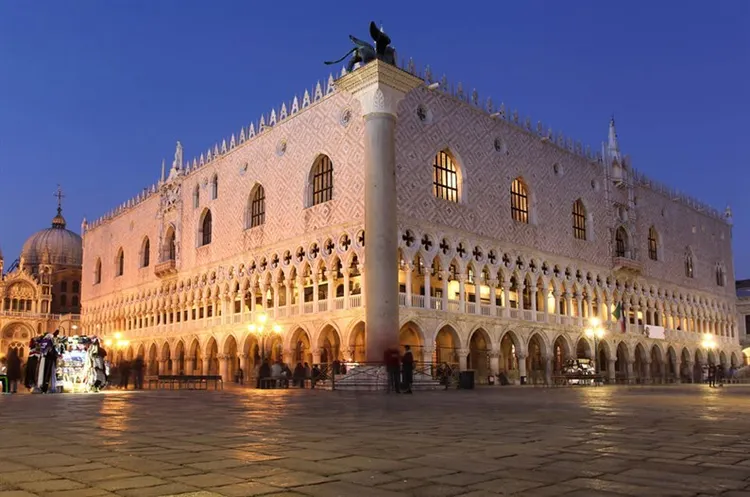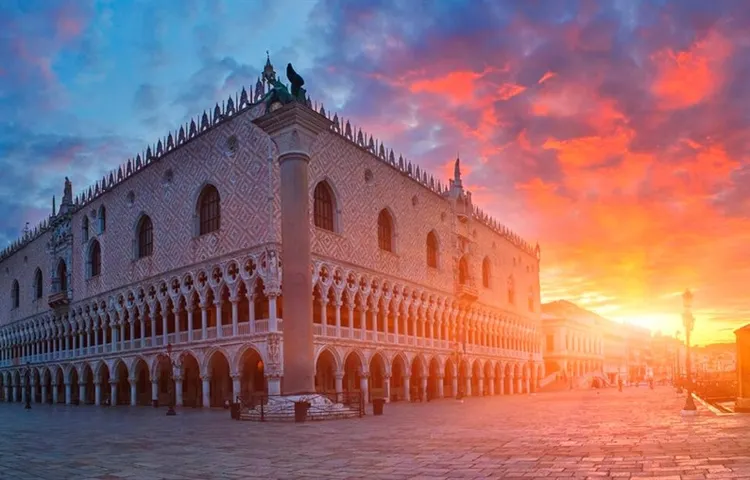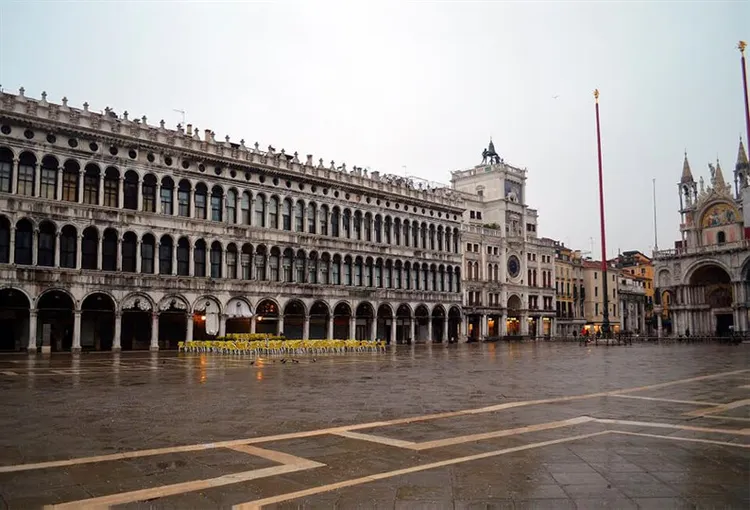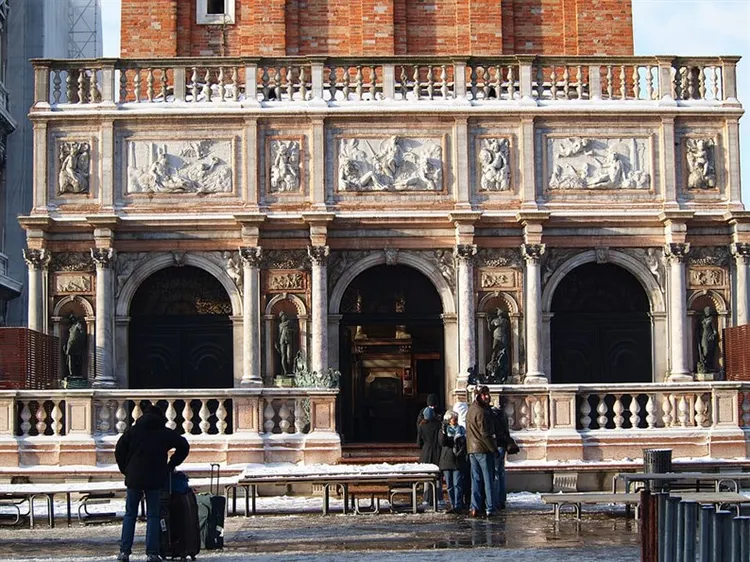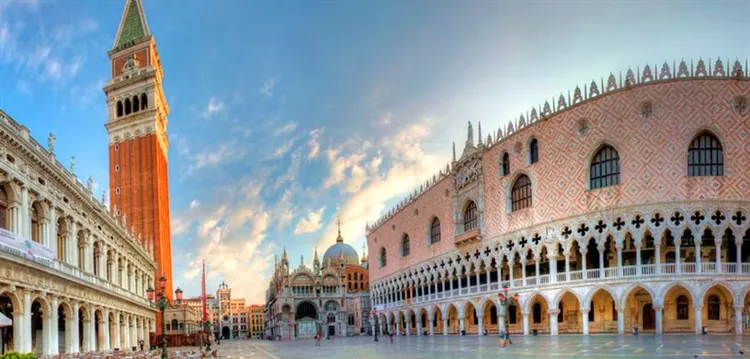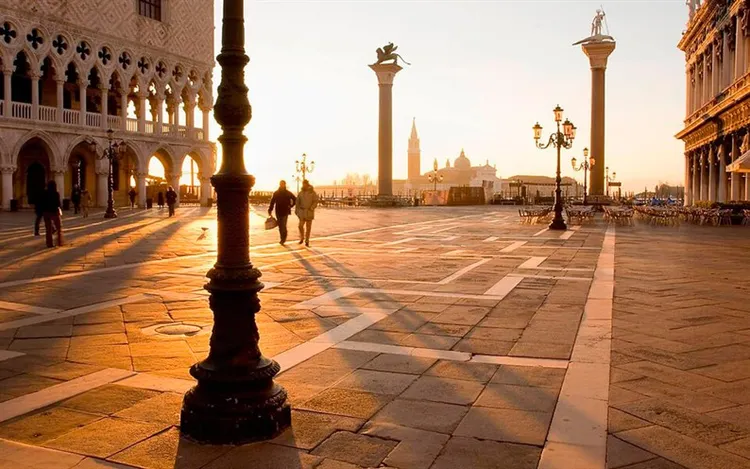Piazza San Marco in Venice – photo, history, description, attractions, how to get there, map
Piazza San Marco in Venice can be conditionally divided into two parts: piazetta and piazzo. The Piazzetta is a small area between St. Mark's Square itself and the Giudecca Canal. It welcomes guests with an entrance gate in the form of two granite columns. To the right of them stands the Doge's Palace (the rulers of the city), to the left is the Marchiana Library, the Piazzetta ends with the Belfry. The center of attraction is the Cathedral of San Marco – the main attraction of the city. No less interesting are the buildings of the Procurations, the Clock Tower, Loggetta. It acquired its modern look, shape, dimensions by 1777. Now its length is 175 m, width is 82 m.
San Marco – the main square of Venice
Heart and business card of Venice. And although there are many other squares in the city, this is the only place called a square or piazza (Piazza), which emphasizes its significance. The rest are called compo (compo), which translates as a small field. Piazza San Marco is a famous historical and cultural center of Venice. For many centuries it has been a place of attraction for millions of people from all over the world. City ceremonies, celebrations and the famous Venice Carnival are held here.
Venice: St Mark's Basilica Skip-the-Line
Ticket Opera La Fenice: Skip-the-Line Ticket with Audio Guide
Short Boat Trip to Murano, Torcello and Burano
Venice: Shared Gondola Ride
Story
The history of this amazing place goes back to 829. Venetian merchants, who had trading business in Egyptian Alexandria, managed to secretly take out the relics of the great Christian saint, the apostle of Jesus Christ – the Evangelist Mark, hiding them in a sarcophagus among pigskins. Apparently they noticed that Muslims never touch the “unclean” cargo. The plan was successful, the customs inspection bypassed them, and the relics arrived safely in Venice.
To accommodate them, the Basilica of San Marco was built, respectively, and the square in front of it was also named. In 976, during a fire, the building was badly damaged. Instead, a majestic cathedral was built. The square gradually expanded, became the center of the city, it hosted all political events, public holidays and even executions.
architectural landmarks
Acquaintance with the sights begins for tourists as soon as they get off the vaporetto (sea taxis). Piazza San Marco is home to a number of historic buildings and structures.
Columns of Saint Mark and Theodore
The first thing that guests see when they step on the piazzetta pavement are two granite columns. They were brought from Constantinople in 1125 and installed only in 1196. The columns are monolithic and very heavy, each weighing more than 100 tons, it is because of this that they could not be installed for a long time. One of the columns is crowned with a marble statue of St. Theodore with a spear trampling a dragon underfoot. This scene symbolizes the power of Venice over the sea. Saint Theodore was the first patron of the city and is still very much loved and revered by the Venetians.
On the capital of another column is a bronze winged lion holding a paw on an open gospel. The lion is the biblical symbol of Saint Mark. It is depicted on the coat of arms of Venice. This figure is more than 2500 years old, according to one version it was brought from China, others see it as an example of Assyrian art. In former times, the space between the columns served as a place of executions. Until now, the Venetians consider it a bad omen to pass where the death sentences were carried out.
Cathedral of San Marco
According to the existing legend, the evangelist Mark preached Christianity in the Venetian lagoon. Once, having got into a terrible storm, he waited for it. An angel appeared in a dream and announced that he would find eternal rest on this earth. And now, for 12 centuries, the relics of the saint have rested under the vaults of the cathedral named after him. At first glance, the Cathedral of San Marco impresses with its magnificence. The basilica, built in 829, was badly damaged by a fire in 976, so they decided to build a new building in its place. The modern look of the cathedral was acquired in 1094.
At that time, the influence of Constantinople on Venice was great. Therefore, the building was erected in the Byzantine pompous style, with a luxury uncharacteristic of the temple buildings of Western Europe. The marble facade is decorated with numerous columns, towers, bas-reliefs, sculptures. The mosaic compositions with the scenes of the Last Judgment and the Theft of the relics of St. Mark are extraordinarily beautiful.
The cathedral has five entrance portals. Above the main one is a majestic bronze quadriga (four horses). The sculptures are attributed to the work of an ancient Greek master of the 4th century BC. They decorated the triumphal arch of Nero in Rome, and then the arch of Trojan. The Venetians got it as a war trophy. The temple is crowned with five domes lined with silvery rectangular plates.
No less impressive is the interior. Because of the abundance of gold, the Cathedral of San Marco is often called the Golden Cathedral. The vaults, walls, domes are covered with multi-colored Murano glass mosaics. The dome is painted with scenes from the Creation of the World. But the main treasure is under the altar: it is a shrine with the relics of St. Mark.
The Golden Altar is a great piece of Gothic art made in 1345. Its dimensions are 3.50*1.4m. It depicts episodes from the Holy Scriptures, the life of St. Mark. Enamels and 2500 stones are inserted into the precious salary: amethysts, emeralds, sapphires, rubies. The iconostasis is made of silver, covered with a layer of gold, decorated with many enamel plates and precious stones.
Clock tower
The building was built in 1499 under the direction of the architect Coducci. The composition consists of four parts. Its main element is a blue-gold astronomical clock. There are two circles on the dial: outer and inner. The golden hand shows the time around the outer circle. On the inside, the signs of the zodiac and the phases of the moon are depicted. Above the clock is a copper statue of the seated Madonna with the Christ Child. Twice a year, on Epiphany and Ascension, the magi appear before her, bowing in bow.
On either side of the statue are small rectangular windows, where the current hours and minutes are indicated. Above is a sculpture of a winged lion holding an open Gospel in its paws. The tower is crowned with statues of two Moors made of bronze: an old man and a young man. They have long hammers in their hands, with which they strike the bell periodically: 5 minutes before the whole hour and 5 minutes later. This is a symbol of the passing of time.
Library of San Marco
The library is on the north side of the Piazzetta. The length of the building is 80 m. It was built in 1537-1545. designed by the architect Sansovino. Initially, the library was intended to store ancient Greek, Latin early printed books and manuscripts (handwritten scrolls) presented to the city by Cardinal Bressanone.
In subsequent years, it was replenished with military trophies, monastic and family collections. Now the library of San Marco (Marciana) has about 40 thousand unique copies. The white marble facade is very elegant, decorated with a balustrade of statues and columns. The interior decoration is no less refined: portraits of famous thinkers and philosophers are on the walls, manuscripts in exquisite bindings are stored in the gilded hall.
Doge's Palace
The building in the Venetian Gothic style, decorated with columns, openwork arches, creates the impression of airiness and lightness. It is located on one side to the sea, the facade – to the square. The Staircase of the Giants leads to the palace, on both sides of it there are two huge statues symbolizing war and the sea: Mars and Neptune. Above them is a bas-relief of a winged lion. Elected doges took their oath here.
The Doge's Palace was built in the XIV century, had several purposes:
In the halls of the magistracy, laws were discussed, political and ecclesiastical issues were resolved, ambassadors and diplomatic missions were received. Court was held in the Senate Hall, and the judicial platform of the 18th century has survived to this day. The interior of the palace is striking in its luxury. The walls and ceiling are lined with marble, tapestries, leather with gold trim.
The decoration is the paintings of brilliant artists such as Titian, Tintoretto, Pordenone, frescoes by Paolo Veronese. Some depict scenes glorifying Venice: victorious battles, building a fleet, naval battles. On others – episodes from the Holy Scriptures, the gods of the ancient world. A unique collection of weapons worthy of special attention: military, decorative, trophy. In total, the exposition includes 2031 items, including the armor of the French king Henry IV, crusader knights, the Turkish standard, sabers, muskets.
Old and New Procurations
The procurators were built to accommodate the highest officials of the executive branch – the procurators. Their duties included the execution of the decisions of the Doge and the Senate in the financial, legal, property, political and other spheres. The first Procuration – the Old – was built on the north side of the square in 1532. This is a long three-story building with arches, loggias, columns. Due to the growing bureaucracy, one building was not enough.
In 1586, the New Procurations were built opposite it. And in 1810, by decree of Napoleon, another building was built in the west of the square – Ala Napoleonica (Napoleon's wing), connecting both Procurations. All buildings are built in the same Renaissance style. Now museums are located on the upper floors, the lower ones are given over to cafes.
Lodgetta Sansovino
The Loggetta is a small, refined building designed by the architect Sansovino in the Baroque style, adjacent to the bell tower. Time of construction: 1537-1540. The facade is made of white and colored marble, decorated with columns, bas-reliefs with scenes from ancient mythology, statues of gods. For a long time, Logetta served as a meeting place for noble patricians. Later it housed the guards of the Doge's Palace. Now through Loggetta enter the observation deck of the bell tower.
Campanile
Campanile – observation deck and bell tower of the Cathedral of San Marco. At the base it has the shape of a square with a side of 12 m, a height of 98.6 m. It is built of brick, crowned with a marble belfry with five bells, decorated with statues of the goddesses of Justice, Venus, Minerva, and the figure of a winged lion. The bell tower ends with a pyramid-shaped spire, on top of which there is a weather vane with a golden archangel 2 m high.
The first tower on this site was built in the 9th century and served as an observation deck and a lighthouse. At the beginning of the 16th century, a new version of the bell tower was built. It stood for almost 400 years and collapsed in 1902. Ten years of work went on, and the original appearance was completely restored.
San Marco – Pigeon Square
Pigeons have become an integral part of Piazza San Marco. According to legend, many guests came to the consecration of the cathedral. Among the gifts were two doves, which were released into the wild. They sat on the eaves of the cathedral, which was considered a symbolic sign, doves were recognized as sacred. Since then, a tradition has developed to protect and feed the birds.
Over time, a great many of them have bred. For sanitary reasons, and in order to limit offspring, pigeons are fed with special food. Until 2008, bags of cereals could be bought on the square, but then the sale was stopped and tourists were forbidden to feed the birds.
Opening hours and ticket prices
The opening hours of the attractions in Piazza San Marco vary by season. The high season is April-October, the low season is October-April.
Cathedral of Saint Mark:
In the low season, the visiting time is reduced by an hour. Entrance to the Cathedral with luggage is prohibited, you can not take photos and videos, speak loudly and be in open clothes.
Doge's Palace:
Opening hours of the palace in the high season: 8.30 – 19.00. In low: 8.30 – 17.30.
Ticket price – 19 €; for children 6-14 years old, people over 65 years old – 12 €. With this ticket you can also enter the Correr Museum, the Archaeological Museum and the library.
Campanile San Marco:
October, Easter holiday – June: 9.00 -19.00; November – Easter holiday: 9.30 – 15.45; July – September: 9.00 – 21.00. Ticket price 8 euros.
Where is it located and how to get there
San Marco is the center of Venice. Since the whole city is located on the islands, vaporettos serve as public transport. These are small motor ships plying between the islands along the Grand Canal along established routes. Venice is connected to the Italian mainland by a causeway. Trains arrive at the Santa Lucia railway station, buses – at the station near Piazza Roma. Further, you can walk to the center or take a vaporetto (travel 7 €) No. 1, No. 2, No. 4.1, No. 5.1 and N (night route) to the Piazzo San Marco pier.
Buses run from the airport, which is 12 km from the city. Their working hours are from 5.20 am to 24.20 pm, the ticket price is 8 €. Stops at the Roman Square.
